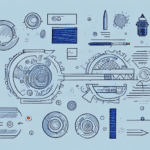Importance of Kitting in Manufacturing
Kitting plays a critical role in manufacturing by streamlining the production process. Instead of searching for individual components, kitting enables workers to access all necessary items in a single kit, enhancing efficiency and reducing assembly time. This approach minimizes errors, shortens production cycles, and allows companies to respond swiftly to changes in demand, thereby improving order fulfillment speed.
Moreover, kitting contributes to cost savings by reducing inventory and storage expenses. By assembling kits with only required components, manufacturers can prevent overstocking and minimize resource wastage. This efficient inventory management not only lowers storage costs but also ensures better space utilization, which is particularly beneficial for companies with limited storage capacities. Additionally, kitting enhances product quality by ensuring the correct components are used consistently, leading to fewer defects and customer returns.
Benefits of Kitting for Businesses
Kitting offers numerous advantages beyond manufacturing efficiency:
- Optimized Labor and Assembly Costs: Workers can complete orders more quickly without the need to locate individual parts, reducing labor costs.
- Space Savings: Consolidating inventory into kits reduces the space required for storage, benefiting businesses with limited storage areas.
- Improved Order Accuracy: With all necessary parts included in a kit, the likelihood of missing or incorrect items decreases, enhancing customer satisfaction and reducing returns.
- Streamlined Supply Chain: Fewer suppliers and simplified ordering processes result in cost savings and increased operational efficiency.
- Reduced Customer Backorders: Ready-to-ship kits decrease waiting times for customers, improving overall service levels.
Implementing kitting can lead to significant operational improvements and a competitive edge in the market.
Types of Kitting Techniques
Several kitting techniques cater to different business needs and operational contexts:
Pre-Kitting
Pre-kitting involves assembling and storing kits in advance based on forecasted demand. This method is ideal for industries with predictable product demand, such as automotive manufacturing. Pre-kitting reduces lead times and enhances production efficiency by ensuring that all necessary components are readily available when needed.
Just-In-Time (JIT) Kitting
JIT kitting assembles kits based on real-time demand data, minimizing inventory costs and improving cash flow. This technique is suitable for industries with variable demand patterns, such as electronics, where product life cycles are short and demand can fluctuate rapidly.
Dynamic Kitting
Dynamic kitting is a flexible method that adapts to real-time inventory changes and production requirements. It allows for on-the-fly adjustments, making it ideal for custom or small-batch manufacturing where product specifications may frequently change.
Each kitting technique offers unique benefits and can be implemented based on specific business requirements and operational dynamics.
Developing a Successful Kitting Strategy
Creating a Successful Kit
The foundation of an effective kitting strategy lies in thoughtful kit design. Start by identifying the components required for each kit and analyzing their usage frequency. Consider the end-user experience to ensure that kits are user-friendly, easy to assemble and disassemble, and tailored to the specific needs of the production process or end customer.
Engaging with a reputable kitting provider can help in selecting the right combination of components and optimizing cost-effectiveness. Additionally, designing durable and protective packaging is essential to prevent damage during shipping and handling, while also reflecting your brand identity.
Common Mistakes to Avoid
- Inadequate Planning: Poorly planned kits can result in incorrect or duplicate components, leading to inefficiencies and increased costs.
- Non-User-Friendly Kits: Kits that are difficult to assemble or disassemble can cause confusion, delays, and errors in the production process.
- Poor Inventory Management: Failing to regularly assess inventory can lead to obsolete or expired components, rendering kits unusable.
- Inadequate Packaging and Labeling: Poor packaging can damage components, and unclear labeling can result in assembly errors.
- Ignoring Environmental Impact: Excessive or non-recyclable packaging contributes to environmental harm and may impact company sustainability goals.
To avoid these pitfalls, implement robust planning processes, regularly assess inventory, and collaborate with experienced kitting providers who can guide best practices.
Best Practices for Efficient Kitting Operations
- Establish Clear Procedures: Define standardized kitting processes to ensure consistency and efficiency across operations.
- Employee Training: Provide comprehensive training to employees involved in kitting operations to minimize errors and enhance productivity.
- Accurate Inventory Tracking: Utilize inventory management systems to monitor component levels and prevent stockouts or overstocking.
- Leverage Technology: Implement automation tools, barcode scanners, and RFID technology to streamline the kitting process and improve accuracy.
- Maintain an Organized Workspace: Keep the kitting area clean and well-organized to promote safety and operational efficiency.
- Regularly Review Strategies: Continuously assess and refine kitting strategies based on performance metrics and changing business needs.
Adhering to these best practices ensures that kitting operations are efficient, scalable, and aligned with overall business objectives.
Selecting the Right Kitting Provider
Choosing an appropriate kitting provider is crucial for the success of your kitting strategy. Consider the following factors when evaluating potential providers:
- Experience and Expertise: Assess the provider’s track record and experience in handling kitting operations similar to your business needs.
- Range of Services: Ensure the provider offers comprehensive services, including assembly, packaging, labeling, and logistics support.
- Customization Capabilities: The ability to customize kits according to specific requirements and adapt to your business’s unique needs is essential.
- Pricing Structure: Analyze the provider’s pricing to ensure it aligns with your budget while delivering value and quality.
- References and Case Studies: Request references and review case studies to gauge the provider’s performance and client satisfaction levels.
- Location and Logistics: A provider with facilities strategically located near your operations can reduce shipping costs and lead times, enhancing supply chain efficiency.
- Scalability: Ensure the provider can scale operations in line with your business growth and changing needs.
Thoroughly vetting potential kitting providers against these criteria will help you select a partner that can effectively support your kitting strategy and contribute to your business’s success.
Future Trends and Innovations in Kitting
The kitting landscape is evolving with advancements in technology and increasing emphasis on efficiency and sustainability. Key trends to watch include:
Automation and Robotics
Automation is revolutionizing kitting by incorporating robotics and artificial intelligence (AI) to enhance accuracy and speed. Automated kitting systems can handle repetitive tasks with precision, reducing human error and labor costs.
Augmented Reality (AR)
AR technology is being integrated into kitting processes to provide workers with real-time guidance and information, improving accuracy and reducing assembly errors. AR can facilitate training and complex assembly tasks by overlaying instructions directly onto the equipment or workspace.
Sustainable Practices
There is a growing focus on sustainability in kitting operations, including the use of biodegradable packaging materials, reducing excess packaging, and optimizing transportation routes to minimize carbon emissions. Adopting eco-friendly practices not only benefits the environment but also meets increasing consumer demand for sustainable products.
Data-Driven Kitting
Leveraging big data and analytics allows businesses to optimize their kitting strategies by forecasting demand more accurately, managing inventory efficiently, and identifying areas for process improvement.
These trends underscore the importance of adopting innovative technologies and sustainable practices to stay competitive in the evolving manufacturing landscape.
Measuring the Success of Your Kitting Strategy
Assessing the effectiveness of your kitting strategy involves tracking key performance indicators (KPIs) that reflect operational efficiency and business outcomes. Important metrics include:
- Productivity: Measure the rate of kit assembly and how it impacts overall production efficiency.
- Cost per Kit: Calculate the total cost involved in creating each kit to identify cost-saving opportunities.
- Error Rates: Monitor the frequency of errors or defects in kits to assess quality control.
- Inventory Turnover: Evaluate how quickly inventory is used and replenished to optimize stock levels.
- Customer Satisfaction: Gather feedback to determine how kitting affects customer experience and satisfaction.
Regularly tracking these metrics provides insights into the strengths and weaknesses of your kitting operations, enabling continuous improvement and strategic adjustments to enhance overall performance.
Case Studies: Businesses That Improved Operations with Kitting
Numerous businesses across various industries have successfully implemented kitting to enhance their operations:
Automotive Industry
A leading automotive manufacturer implemented pre-kitting to assemble car parts before delivery to the assembly line. This approach reduced setup times by 25%, increased production rates by 15%, and minimized waste, resulting in substantial cost savings and improved efficiency.
Healthcare Sector
A medical supply company introduced kitting for surgical instruments, bundling all necessary tools into standardized kits. This change decreased assembly time by 30%, reduced labor costs by 20%, and improved the accuracy of instrument sets, leading to higher customer satisfaction and lower return rates.
Electronics Manufacturing
An electronics firm adopted JIT kitting to manage fluctuating demand for components. By aligning kit assembly with real-time demand data, they reduced inventory holding costs by 18% and enhanced cash flow, while maintaining high levels of order accuracy and fulfillment speed.
These case studies demonstrate the tangible benefits of kitting in terms of efficiency, cost savings, and customer satisfaction across different sectors.
Conclusion
Kitting offers significant advantages in manufacturing and business operations by streamlining production processes, reducing costs, and enhancing product quality. To maximize these benefits, it is essential to develop a strategic kitting plan that includes thoughtful kit design, avoidance of common pitfalls, adherence to best practices, and selection of a reliable kitting provider. Embracing emerging trends and continuously measuring performance ensures that your kitting strategy remains effective and evolves with your business needs. By implementing an optimized kitting strategy, businesses can achieve greater operational efficiency and a competitive edge in their industry.






















